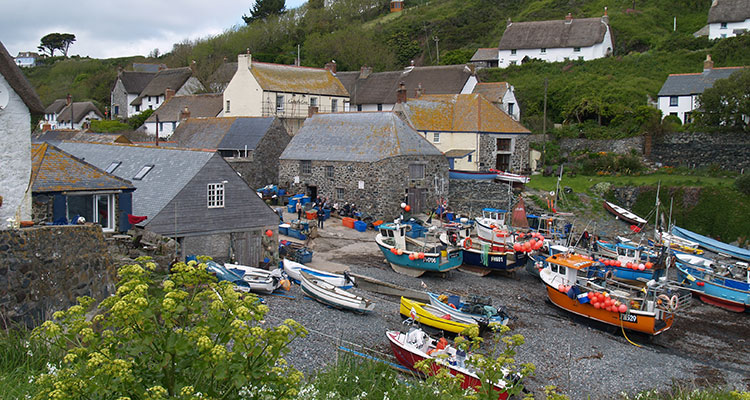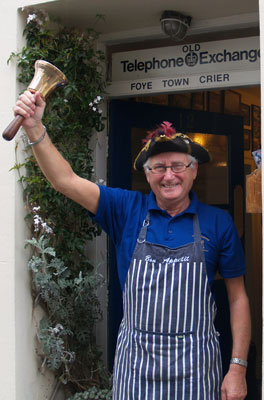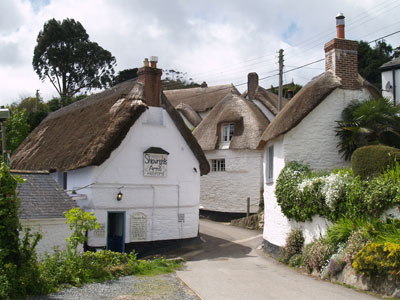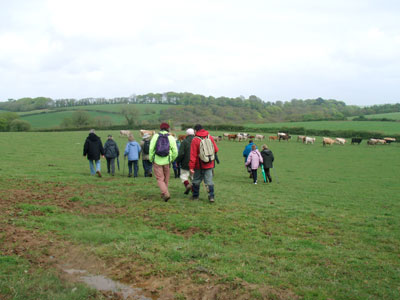Compact Cornwall – this tiny English county is packed with colorful surprises
This article appears on page 50 of the January 2013 issue.
by Yvonne Horn; Contributing Editor
At 80 miles east to west and less than seven miles across at its narrowest point, Cornwall, England’s most southwesterly county, isn’t very big. However, despite its small size, it sure was easy to get lost! Without the patient GPS lady at my side — “Please make a U-turn at the earliest opportunity” — I’d probably still be wandering Cornwall’s tangled ribbon of narrow lanes looking for my first night’s B&B.
Tall stone “hedges,” overgrown with years of greenery, were erupting gloriously on either side of the road with additions of bluebells, froths of wild garlic, yellow ragwort and rose champion — all the while threatening to take out both of my car’s side mirrors. Meeting another car inspired panic.
Luckily, my 2012 trip took place in May; it would be hard to imagine the nightmare of these lanes when the emmets arrive. Derived from the Old English word for “ant,” emmet is the descriptive word used by the Cornish to describe the hordes of holidayers (mostly Brits, some Germans and, rarely, an American) who arrive mid June through September to swarm about its postcard-picturesque villages, countryside and beaches.
Along with far fewer tourists, spring and autumn bless Cornwall with some of its best weather.
Making arrangements
Cornwall packs a wallop of camera-worthy diversity into its small corner of England, from sweeping, stark moors to its cove-gashed seacoast. So notable are the county’s landscapes that 958 square kilometers, spread out over 12 locations, are designated as Areas of Outstanding Natural Beauty, granting Cornwall the largest number per county of the 46 areas so designated throughout all of England and Wales.
Before leaving home, I organized stays of two nights in each of five B&Bs, their locations chosen to follow my explorations from the county’s eastern edge to its most westerly, then up its northern coast. All were found using Visit Cornwall’s excellent website, Alastair Sawday’s guidebook “Special Places to Stay, Devon and Cornwall” and the Web guide at www.sawdays.co.uk. With these resources, I found accommodations that met my criteria of “shouting” Cornwall while costing less than $100 a night, including breakfast.
I made reservations directly with the owners via e-mail, learning in the process that none take credit cards. Payment was requested in pounds by check or in cash, options that might present a problem for those living outside the UK.
By e-mail, I was able to give each owner assurance that my flights were booked, my car rental was arranged for and they could count on my arrival.
Thinking that ATMs might be difficult to find, I decided to carry cash with me. I was able to purchase pounds from my local bank in an amount sufficient to cover the cost of the B&Bs and still have an extra stash of spending money. While many restaurants and all gas stations took credit cards, small establishments and most pubs did not.
The B&Bs
All of the B&Bs were located in the countryside, with one exception.
Three-room Buttervilla Farm (phone 01503 230315), located outside St. Germans, is a grower of organic produce for local restaurants, making breakfasts at this B&B a standout.
Carmelin (phone 01326 290677), a one-suite B&B on the Lizard Peninsula, featured a sunroom with sweeping views across the headlands and straight out to the sea.
The rambling Old Vicarage (phone 01288 331369) in Morwenstow, on the northern coast, offered a large dose of theatrical eccentricity with a décor featuring collected objets, from gramophones to policemen’s helmets.
The reason for avoiding city accommodations, small as Cornwall’s cities are, was twofold: not only did those accommodations tend to be more expensive but, most importantly, staying in a city meant driving narrow streets to reach it, not to mention the necessity of parking in a car park outside the town center.
My single city stay was in Fowey at the Foye Old Exchange (phone 01726 833252). A spacious suite overlooking the main street was a secondary plus to my greeting at the door by the booming equivalent of “All hail the Queen!” The proprietor is also Fowey’s official Town Crier.
Stepping into the pages
The 16th annual Daphne du Maurier Festival was under way during my visit, with a program packed with lectures, programs and outings. Du Maurier, best known for her novels “Jamaica Inn,” “Frenchman’s Creek” and “Rebecca,” written in the 1930s and ’40s, found inspiration in her beloved Cornwall. Listed in a 12-day lineup of events was a 5-mile literary walk.
I met my group of fellow walkers at Lerryn Village, on the edge of River Lerryn, in addition to a Blue Badge guide who was ready to lead our trek, which began with a hopscotch crossing of the river via 24 stones.
Not far into the walk, I began to catch on that this literary walk followed more in the footsteps of Kenneth Grahame, author of the enduring and endearing children’s book “The Wind in the Willows,” than it did in tracking du Maurier. Grahame, too, found inspiration in Cornwall, and our guide stopped at points along the way to read excerpts from the book.
Near a wooden bridge, willows were bending in the breeze, making it easy to visualize it as the place Grahame chose to pen his story.
Farther on foot
I’ve long believed that the best way to get to know a place is on one’s own two feet, especially in the company of locals. On prior visits to the UK, I’ve turned to Britain’s Ramblers Association, instrumental for over 75 years in promoting walking and the right to roam the countryside. Visitors are always welcome to tag along.
Turning to the Web, I found the Ramblers well represented in Cornwall and discovered two scheduled walks that would fit my itinerary.
The first took me into the sweeping openness of Goss Moor, a National Nature Reserve courtesy of the marsh fritillary, an endangered butterfly. “Goss Moor” is derived from the Celtic word meaning “a boggy or marshy place.” With plentiful conversation along the way, the group I joined traipsed a mosaic of heathland, waterways, marshes and pools, crossing an area rich in wildlife.
To reach the starting point of my second trek, I followed my GPS lady again into the moors, this time Bodmin Moor, on my way to St. Agnes, a slate-and-granite village tumbling into the sea on England’s western coast.
The terrain of Bodmin Moor was stark, yet, in its own way, stunningly beautiful, with granite outcroppings, expanses of heather and gorse, and rock-studded farmland defined with stone walls. Derelict engine houses with smokestacks reaching to the sky dotted the landscape, presenting a veritable tin-mining graveyard — monuments to an era when mining was king and Cornwall, rich.
The walk this day took in a stretch of Cornwall’s 258-mile Coast Path and included a turn inland for the climb to St. Agnes Beacon. Our reward at the top was incomparable panoramic views.
Area attractions
A short drive north from St. Agnes took me to Tintagel and its widely visited castle ruins with an association to the legend of King Arthur. There, I learned that the castle was built in 1236 by Richard, Earl of Cornwall (a King Arthur admirer) in the style of King Arthur’s day.
Archaeological excavations through the decades have unearthed evidence that during the Dark Ages, the time of the legendary King Arthur, an important trading post was located there. In 1998, a piece of Cornish slate was unearthed bearing an inscription that some archaeologists believe further ties the site to, if not the legendary Arthur, an equally important person. Had myth met history? It was a question for me to ponder as I took in the wild and wonderful coastal views.
Another of Cornwall’s most-visited attractions is St. Michael’s Mount, a tidal island topped by a castellated mansion, much like Normandy’s famed Mont-St-Michel which sits directly across the English Channel.
The tide was out at the time of my visit, allowing me to walk the quarter-mile cobblestone causeway to the island. When the tide is in, a motorboat ferry (£2) carries visitors back and forth.
Once home to a fortified Benedictine priory, the castle has been owned and continuously lived in by members of the St. Aubyn family since 1647.
Most people visit the island to tour the castle’s grand public room. Not to be missed, however, are the terraced gardens on the island’s south side. (See ITN, Nov. ’12, pg. 57.)
Cornwall has been described as “the garden capital of the world,” and well it might be with some 60 estates welcoming visitors. (For more information, visit www.gardensofcornwall.com.)
Most of the gardens had their beginnings in the Victorian era, a grand time for plant collectors, as ships dispatched throughout the world for the Crown brought back specimens and seeds. “Show-off” gardens resulted, with estates vying for the most rare and exotic plants to display in extravagant landscapes.
St. Ives
While I’d purposefully avoided towns of size, how could I skip St. Ives with the nursery rhyme “As I was going to St. Ives…” running through my head?
Rather than navigate the town’s hilly, cobbled streets and car park, I headquartered in nearby Lelant at the one-suite Penquite B&B (phone 01736 755002). Parked at Lelant’s little railroad station, I hopped aboard the Bay Line for the 10-minute ride (£2, or $3.20) to St. Ives’ center.
St. Ives is notable not only for its picturesque seaside setting but for its top-shelf artistic attractions that include galleries and workshops. The prize is a branch of London’s Tate, opened in 1993, which overlooks the sandy curve of Porthmeor Bay (admission, £6.50).
Under Tate auspices, the Barbara Hepworth Museum & Sculpture Gardens (£5.50) is housed in the former studio of the great British sculptor. Paths wander through her carefully designed, yet informal, garden-turned-gallery, with examples of her massive pieces of work on display at every turn.
Leach Pottery includes a visitors’ center with exhibits detailing the history of studio ceramics and art traditions in St. Ives.
Village visits
Enchanting among Cornwall’s hamlets and small towns were the tiny, unspoiled-by-the-march-of-time fishermen’s villages tucked into natural breaks in the Lizard Peninsula’s cliffs. Not to be missed is Cadgwith, with its 300-year-old stone cottages and buildings that contain “hidey holes” for spirits and tobacco, contraband dating from the time when the Lizard’s rugged coast was a magnet for smuggling and shipwrecks.
Landewednack is another, with its stone church and tower constructed of glossy green and velvet-black serpentinite. Pretty thatch-roofed houses line the lane leading down to the village’s compact cove, bright with colorful fishing boats pulled up on the beach.
At idyllic Helford village, on the Lizard’s eastern edge, I walked a winding lane fringed with whitewashed cottages — many brightened with froths of pink clematis clambering over entry doors — that took me to the Helford ferry. Connecting the north and south banks of the river, the ferry (£5.50 round trip) has provided a vital link since the Middle Ages.
“The best pasties in Cornwall are on your way to Helford,” the proprietress of my Lizard Peninsula B&B told me. Considered the national dish of Cornwall, pasties (say “pass-tees”) were carried by Cornish tin miners, providing a complete, handheld meal. The pastry, shaped like a “D” and crimped at the edge, traditionally holds a concoction of potato, onion and turnip. “Meat can be added,” David Gear told me, “traditionally stuck in to make use of and disguise that (which has) gone a tad bad.” Gear uses thinly sliced steak in his nonvegetarian pasties.
A tangle of narrow lanes took me to Gear Farm (phone 01326 221150), which organically grows all of its pasty ingredients. They turn out some 1,500 pasties each day, with most going to London’s Whole Foods Markets.
While one pasty, even Cornwall’s best, was enough to satisfy me for the rest of my natural life (though one should not miss trying this national dish), the pubs and restaurants that the B&B owners on my trip directed me to as their favorites never disappointed.
The staff at Buttervilla recommended the nearby Rod & Line (phone 01752 851323), a rough-edged, authentic Cornish pub where I dined on impeccably prepared scallops so fresh that I suspected they had been pulled from the sea by one of the fishermen chatting it up with his buddies at the bar.
Gurnard’s Head (phone 01736 796928), an upscale pub not far from St. Ive’s on the windswept headlands of Land’s End, offers a fine-dining, seasonal menu with most main dishes priced around £16.50 ($26.50).
My B&B on the Lizard Peninsula suggested the Polpeor Café (phone 01326 290939), located in an old coast guard station on the cliffs of England’s most southerly point. Nicely prepared, cooked-to-order traditional items were on the menu. Bring your own bottle of wine to enjoy by the wide windows or out on the terrace, inches from the sea, as the sun sets over the Atlantic.
I found Cornwall to be one of the most diverse, authentic, untouched, untrammeled areas of England.




